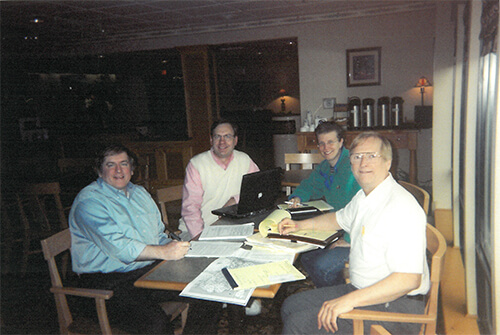CODA, founded only a decade ago by a small group of dedicated conductors, has become an important resource for currently over 400 members nationally, multiple Canadian provinces, and many countries in South America and Europe.
A Great Idea
The College Orchestra Directors Association (CODA) was founded on May 25, 2003 by James Madison University orchestra director Robert McCashin and Baylor University director Stephen Heyde. McCashin had been influenced by his band colleagues’ positive experience with the College Band Directors National Association (CBDNA) and felt there should be a similar support organization for college orchestra directors. This idea was supported by Heyde, and a campaign to recruit members began.
The effort to create the organization initally began in 1995, when McCashin sent an “interest” letter and survey to directors around the country. This was followed by a 1996 response that indicated a high level of interest. An early version of the organization’s name was CUCODA (College University Conservatory Orchestra Directors Association), but thankfully, it was eventually whittled down to CODA.
A Delayed Start
A small group of directors including McCashin, Heyde, Kathleen Horvath, and Kevin Miller met for the first time in Pittsburgh on May 5, 2003. Why the delay from 1996? McCashin explained, “I had been distracted by personal and professional issues and set the organization aside for a while. It was Steve Heyde who called me sometime around 2001 and asked, ‘you know that organization that you tried to start back in the mid 90’s? I think it’s time to move on that.’ So we did.”
The First Meeting: Humble Beginnings


Forming the Organization
A national board was formed in 2003 with McCashin serving as the first national President, and Heyde as President-elect. From its original core of just four members, CODA reached 81 members by the end of its first year. An organizational plan and mission was drafted, and a logo was created in 2003.
Leaders met again at Cleveland State University in 2004 to “jump start” membership. Bylaws were crafted and ratified, and the organization was divided into 5 regions across the country, each with its own officer corps. Regions were encouraged to hold semi-annual conferences, alternating with a semi-annual national conference.
Publications
In September, 2006 it was decided that CODA should have its own peer-reviewed scholarly online journal. One year later Vol. 1, No. 1 of the CODA Journal appeared with Jon Mitchell as editor, Wayne Bennett as Assistant Editor, and Leonard Atherton as Chair of the Peer Review Committee. Among the later Assistant Editors have been Joel Neves, James Waddelow, Patricia Sparti, and David Kozamchak. In 2018 the editorship was passed along to future CODA president Christopher Dobbins.
In 2013 another publication was added. The “Da Capo” newsletter was founded by Charles Gambetta. This in turn led in 2022 to “CODA Matters,” edited by Thomas Taylor Dickey.
The First National Conference
The first national conference was held at Florida State in 2006, followed by Brigham Young University (2008), Kennesaw State University (2010), and Northwestern University (2012). By 2008, just five years after that initial meeting, CODA reached 105 members. By the summer of 2013, CODA surpassed 200 members.

Regional conferences had also been held in off years in various locations, and served as a great way for colleagues to connect on local levels. Starting with their 2013 conference at Baldwin-Wallace Conservatory, Cleveland, Ohio, CODA decided to hold the national conference each year.
By February of 2019, CODA membership had grown to 340 members from 43 states, including honorary and international members. CODA members direct orchestras of all collegiate genres, including conservatories, large public universities with graduate programs, large private institutions, medium-sized programs with undergraduates only, small private and public colleges, college-community orchestras, and college-professional partnerships.
Creating a Brighter Future
In 2012, CODA moved to expand internationally, and instituted a membership drive outside the United States. While CODA members direct orchestras of diverse sizes and scope, the organization is united by the underlying principles that connect collegiate orchestra directors everywhere: education, performance, and community engagement. These tenets serve as the organizational underpinning of this new website, and reinforces the vigor of our mission as academic conductors.
In 2013, largely through the efforts of German Gutierrez, CODA became associated with Ibermusicas, essentially a podium exchange program, though in reality much more than that.
Our Mission
The mission of the College Orchestra Directors Association is to promote and advance college and university orchestra programs through the collaborative assistance, insights, knowledge, creativity, resources and shared vision of its members. CODA champions the art of conducting, teaching and performing orchestral music and strives to encourage and support the artistic, professional and personal growth of college orchestra directors and their students. The association serves as an advocate for the crucial triple roles of the orchestra director in the higher education community; namely, encouraging the development of artistic skills that are the essence of quality conducting, providing resources to better educate students of all majors, and promoting the conductor’s public role in the community.
